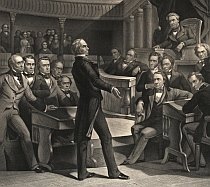Warning: Polemic Article!
You
probably already know the U.S. Senate has something called a
filibuster, and you may also know that there is a rule called the
cloture rule that requires 60 votes to override a filibuster. What is
less well known is that a simple majority vote on procedural rules at
the beginning of the session would be sufficient to remove the cloture
rule. This action is often called the nuclear option, but
proponents have referred to it as the constitutional option.
I think the strong terminology is used because there would likely be a legal challenge that could possibly be accepted for review by the Supreme court. But legal challenges at every political level happen regularly, and nothing would be lost by trying.
The point of all this is, if your favorite political party has a majority in the Senate, but then complains that the opposition keeps rejecting cloture, you can and should laugh at them. They are just putting on what I call a dog and pony show.
Historical backdrop ref wikipedia
In 1892, the U.S. Supreme Court ruled in United States v. Ballin that both houses of Congress are parliamentary bodies, implying that they may make procedural rules by majority vote. In 1917, Senator Thomas J. Walsh [9] contended the majority of the Senate could revise a procedural rule at any time, despite the requirement of the Senate rules that a two-thirds majority is necessary to approve a rule change. "When the Constitution says, 'Each House may determine its rules of proceedings,' it means that each House may, by a majority vote, a quorum present, determine its rules," Walsh told the Senate. Opponents countered that Walsh's constitutional option would lead to procedural chaos, but his argument was a key factor in the adoption of the first cloture rule later that year. In 1957, Vice President Richard Nixon issued an advisory opinion stating that no Senate may constitutionally enact a rule that deprives a future Senate of the right to approve its own rules by the vote of a simple majority. [10] Nixon's advisory opinion, along with similar opinions by Hubert Humphrey and Nelson Rockefeller, has been cited as precedent to support the view that the Senate may amend its rules at the beginning of the session with a simple majority vote. [11]
I think the strong terminology is used because there would likely be a legal challenge that could possibly be accepted for review by the Supreme court. But legal challenges at every political level happen regularly, and nothing would be lost by trying.
The point of all this is, if your favorite political party has a majority in the Senate, but then complains that the opposition keeps rejecting cloture, you can and should laugh at them. They are just putting on what I call a dog and pony show.
Historical backdrop ref wikipedia
In 1892, the U.S. Supreme Court ruled in United States v. Ballin that both houses of Congress are parliamentary bodies, implying that they may make procedural rules by majority vote. In 1917, Senator Thomas J. Walsh [9] contended the majority of the Senate could revise a procedural rule at any time, despite the requirement of the Senate rules that a two-thirds majority is necessary to approve a rule change. "When the Constitution says, 'Each House may determine its rules of proceedings,' it means that each House may, by a majority vote, a quorum present, determine its rules," Walsh told the Senate. Opponents countered that Walsh's constitutional option would lead to procedural chaos, but his argument was a key factor in the adoption of the first cloture rule later that year. In 1957, Vice President Richard Nixon issued an advisory opinion stating that no Senate may constitutionally enact a rule that deprives a future Senate of the right to approve its own rules by the vote of a simple majority. [10] Nixon's advisory opinion, along with similar opinions by Hubert Humphrey and Nelson Rockefeller, has been cited as precedent to support the view that the Senate may amend its rules at the beginning of the session with a simple majority vote. [11]
=================================
[1.] ref. nuclear option & constitutional option
http://en.wikipedia.org/wiki/Nuclear_option#Historical_backdrop
[2.] ref. Fillbuster
http://en.wikipedia.org/wiki/Filibuster_%28United_States_Senate%29#cite_note-rule22-0
[3.] ref. Cloture
http://en.wikipedia.org/wiki/Cloture
Historical Backdrop
[9]# Gold, Martin (2008). Senate Procedure and Practice (2nd ed.). Rowman & Littlefield. p. 49. ISBN 9780742563056. OCLC 220859622. Retrieved 2009-04-29.
[10]# See 103 Cong. Rec. 178-79 (1957) (statement of Vice President Nixon). See also M. Gold & D. Gupta, The Constitutional Option to Change Senate Rules and Procedures: a Majoritarian Means to Overcome the Filibuster, 28 Harv. J. L. & Pub. Pol'y 205, 236–39 (2004) (discussing Nixon's advisory opinion).
[11]# See Christopher M. Davis and Betsy Palmer, Proposals to Amend the Cloture Rule, CRS Report RL32149 (Feb. 17, 2005), at 5–6 PDF.
Full permission for non-profit distribution

Just to make things a little more
complicated
The Presiding
Officer is the person who presides over the United States
Senate, who is charged
with, among other things, interpreting the
Senate's rules,
practices and precedents.
There is no actual office of "Presiding Officer." Whoever is presiding at the time is the Presiding Officer.
This can be the President of the Senate (the Vice President of the United States), or the President pro tempore, who is elected by the Senate and is customarily the most senior senator in the majority party.
Normally, neither the Vice President of the United States nor the President pro tempore presides; instead, the duty is generally delegated to the junior senators of the majority party to help them learn parliamentary procedure.